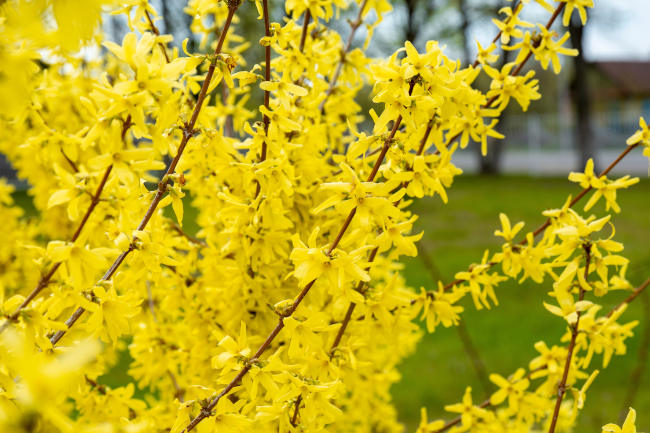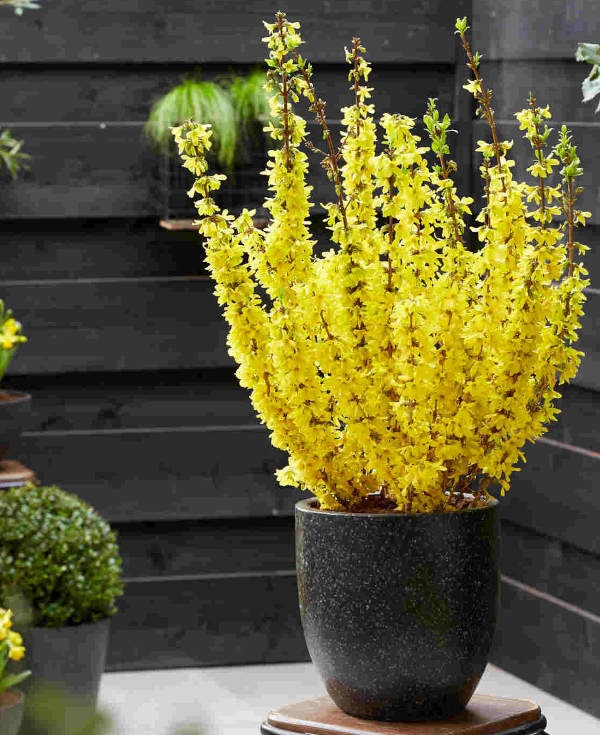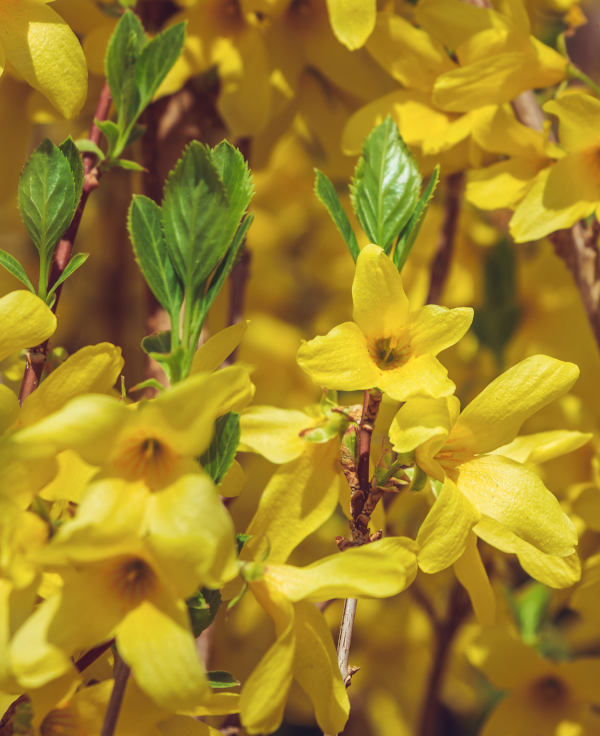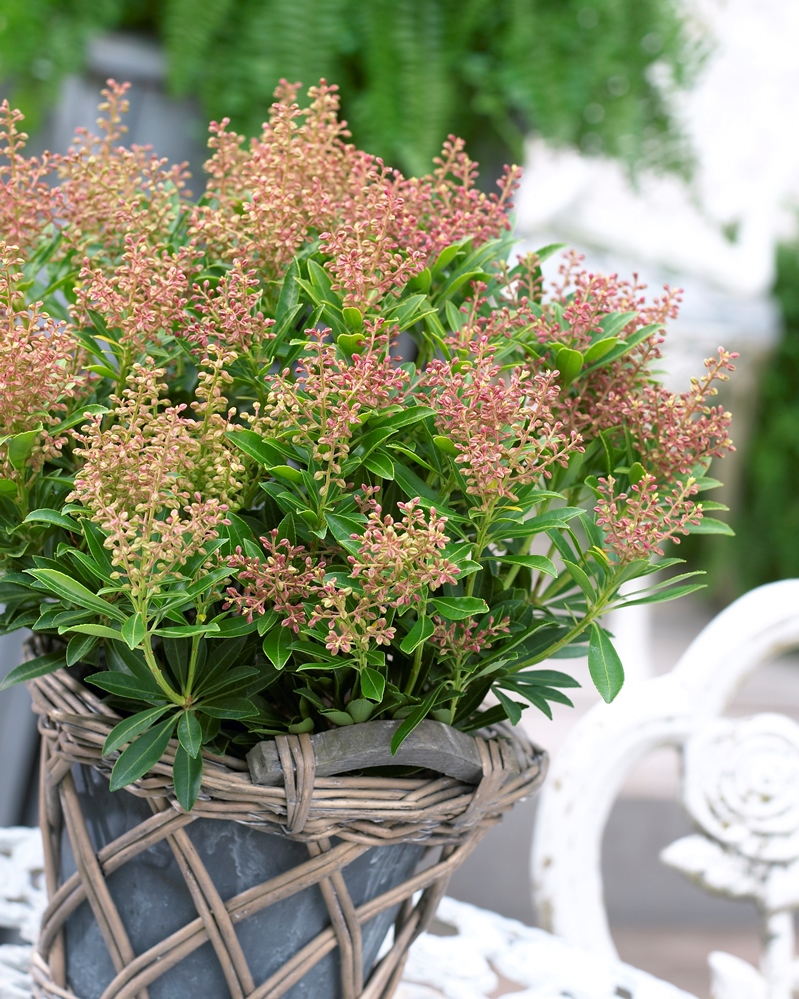How to grow Forsythia
Renowned for its profusion of bright yellow flowers borne on dark, bare stems, the much-loved forsythia is, for many, a cheery, welcome sight during the stark days of early to mid-spring.
Every year, this deciduous, flowering shrub reveals its widespread presence by erupting into startling, blazing patchworks across cities, towns, and villages. After this, forsythia retreats quietly back into the periphery, flowers replaced by perfect pleasant green foliage.
The enduring popularity of forsythia stems from the speed and ease at which it can be grown in most situations, and the minimal maintenance required thereafter. Left to grow naturally, forsythia forms an arching shrub, though is often clipped into a more solid-looking hedge.
The genus is named after Scottish botanist William Forsyth (1737–1804), a royal head gardener and founding member of the Royal Horticultural Society.

Key Information
Position
Hardiness


Where & when to plant Forsythia
For best results, plant pot grown forsythia in autumn or spring. An autumn planting is suitable for those gardening in ‘mild’ conditions. (Broadly speaking, this is the southern half of the UK). For those liable to very cold winters or waterlogged ground, it is best to wait until spring. (This is generally the northern half of the UK, or anyone gardening on heavy, clay soil).
Planting can be done at other times throughout the year providing a watchful approach to watering is taken until plants are established.
When planting a forsythia in bare root form (this will be during winter), place into the ground as quickly as possible, providing the soil is not frozen or waterlogged; if it is, temporarily pot into slightly moist compost, until conditions are more favourable.
Forsythia are hugely versatile shrubs, and can be used in mixed shrub borders, on banks, against walls, as specimen shrubs, and as hedging. Smaller varieties can also make good container plants.
How to plant Forsythia
- Clear the area of weeds
- Dig an extra deep planting hole and add well-rotted organic matter
- Place the plant in the hole
- Backfill with soil and gently firm in with foot
- Soak well with water
- Mulch around the base with well-rotted organic matter
- Continue to water well until fully established.

What to plant with Forsythia
The bright, golden yellow of forsythia is a force to be reckoned with, needing only a delicate smattering of contrasting blue to truly shine. Consider underplanting with spring crocus, chionodoxa, or winter windflower for a subtle yet striking effect.
Dwarf forsythia grown in a container looks spectacular placed among pots of Iris reticulata.
If this all sounds a little too restrained and you would prefer to have a riot of spring colour, combine with azaleas, ornamental cherries, pieris, and flowering quince for a bold, exuberant display.
Should you like any further planting ideas or growing advice for your forsythia, please contact our friendly and knowledgeable Customer Care Team - we will be more than happy to help you.



How to care for Forsythia
Pruning and Deadheading
Forsythia flowers on the previous year’s growth. This means pruning should be carried out immediately after flowering, to allow for the most regrowth possible in time for next year’s display.
Young plants should be allowed to develop naturally with minimal pruning. In these first few years, simply remove any dead, damaged, or badly positioned shoots after flowering. Once established, prune flowering stems back to a strong, outward facing bud lower down, as well as taking out a quarter of old stems at ground level. This will promote new, vigorous growth, and keep the shrub looking tidy and attractive.
Watering
Keep forsythia well-watered throughout the first year after planting, after which it should require little in the way of irrigation.
Cold Protection
Forsythia is fully hardy, requiring no cold protection.
Pests and Diseases
Forsythia is unlikely to be affected by pests and diseases. However, in some cases a fungal infection can cause forsythia gall. This looks like a ragged, light brown swelling on the stems, and should be cut out and destroyed to prevent spread.
Another issue reported by some growers, though again, generally uncommon, is birds eating the flower buds. If you suspect this may be happening, you can net the shrub, or perhaps take the simpler approach of putting bird feeders nearby.
How to propagate Forsythia
Take softwood cuttings in spring or early summer, or semi-ripe cuttings in late summer.
Softwood cuttings are the soft, pliable tips of new, non-flowering growth.
Semi-ripe cuttings are these same shoots later in the year, by now firm and woody at the base.
- Snip off the plant, if possible taking a longer piece than the ideal eventual length of around 10cm (to allow for trimming)
- Put cuttings in plastic bag straight away, to prevent drying out
- Fill container/s with a perlite-heavy compost mix (at least 50% perlite)
- Trim end of cutting to just below a node (point at which leaves grow)
- Remove lowest leaves and soft tip, leaving 2-4 leaves
- If remaining leaves are large, cut in half with a sharp knife (to reduce water lost through transpiration)
- Insert cuttings into compost and water well. You can have several cuttings in the same container if there is enough space to do this without them touching
- Place in a greenhouse if you have one, or covered with a plastic bag on a windowsill if not (out of direct sunlight)
- Keep compost moist but not saturated until cuttings root; look for roots appearing out of the bottom of the container
- Gently remove from container, put into individual pots, and grow on until large enough to plant out
Common Forsythia Questions:
Is there anywhere forsythia will not grow?
Forsythia does not do well in very dry, or waterlogged soil.
It will tolerate shade, though flowers poorly.
Does forsythia have any additional uses?
Flowering stems can be cut and taken indoors, for a bright, long lasting spring display.




